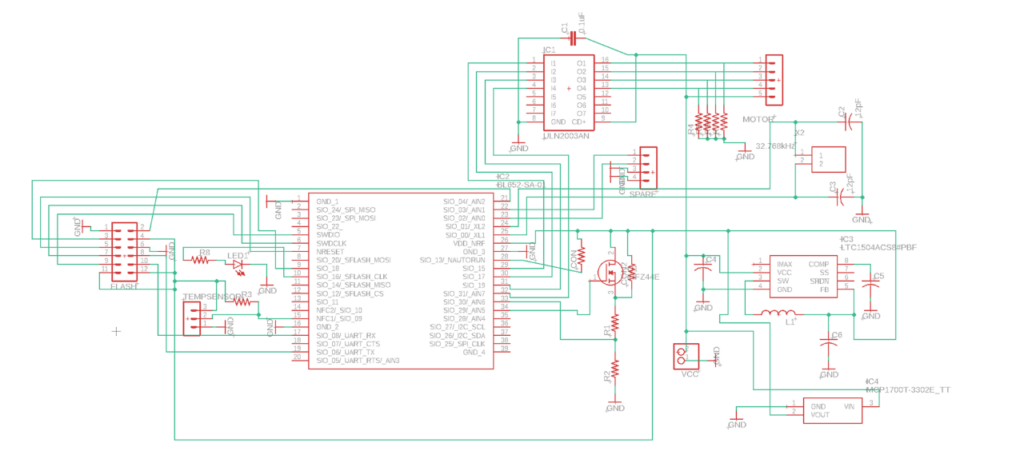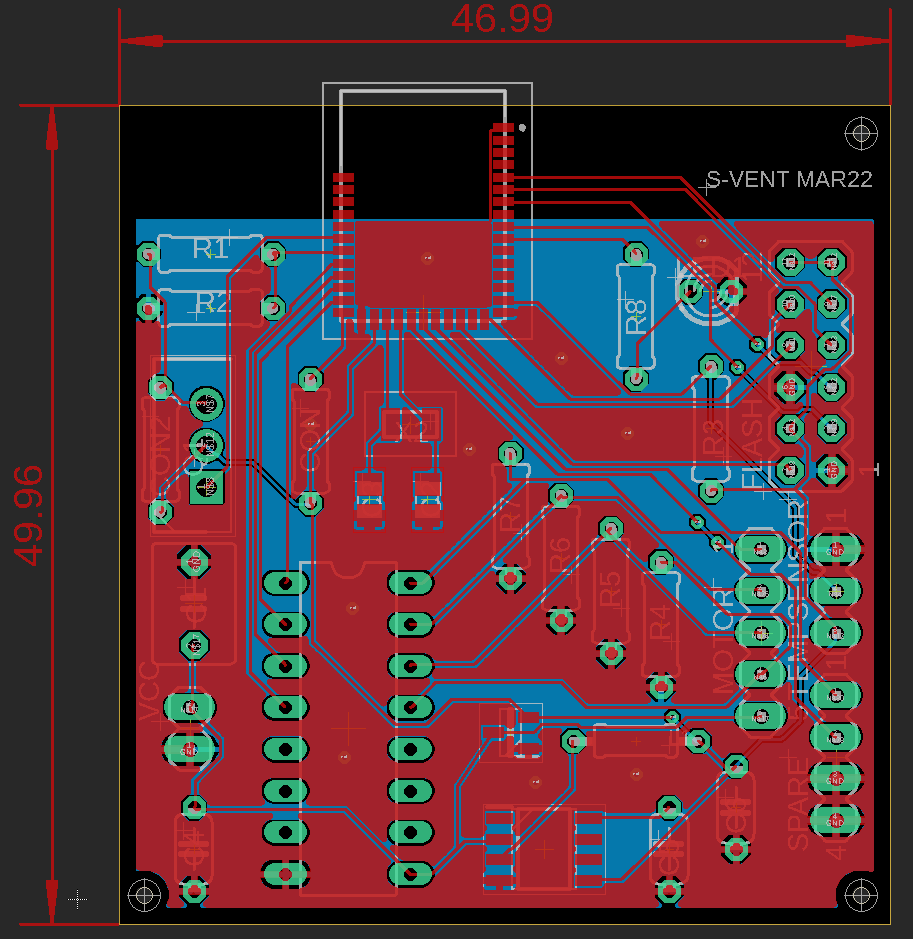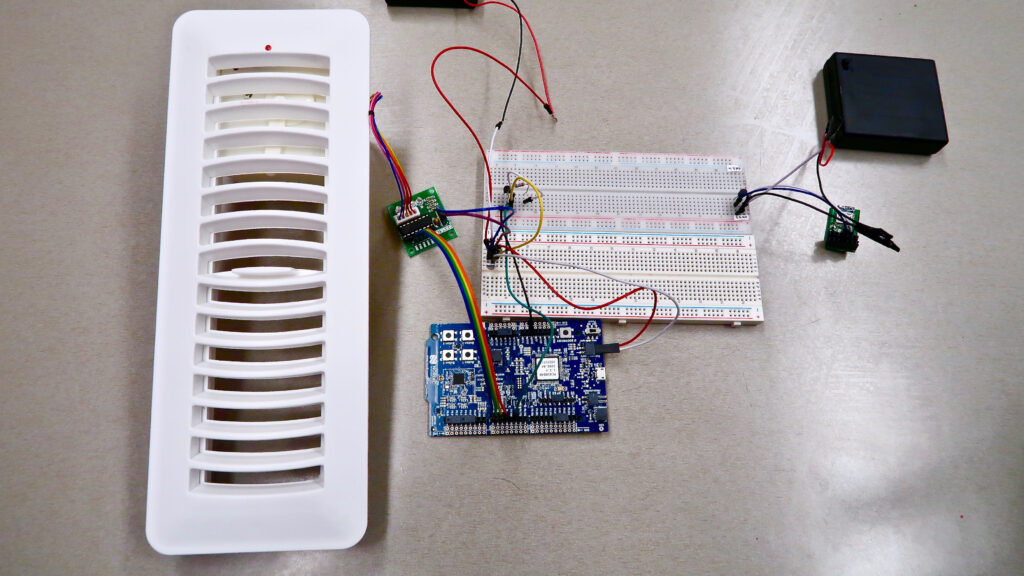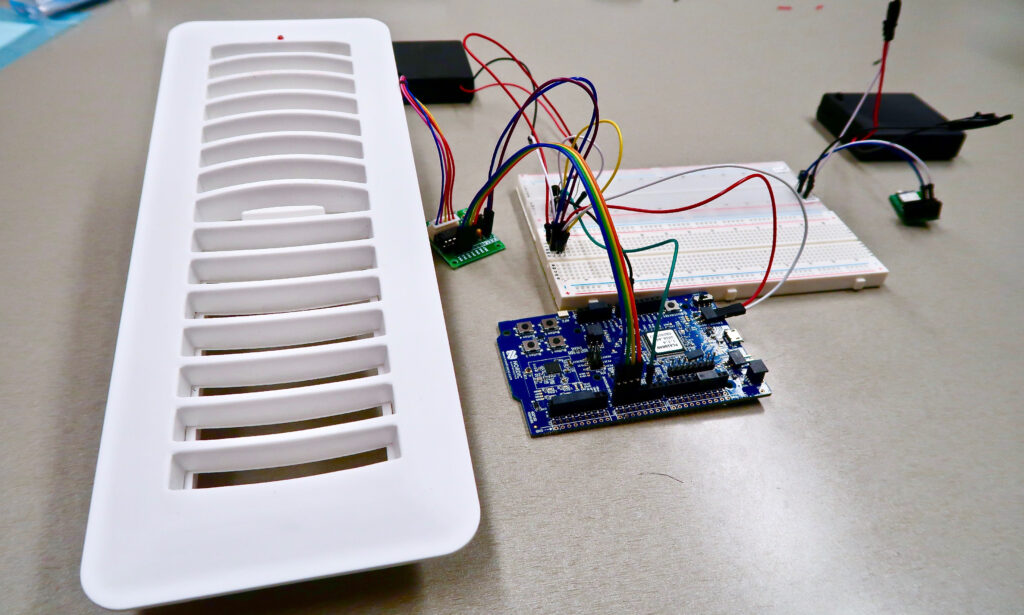Project Category: Electrical
Join our presentation

We will be presenting in-person at the 2022 Capstone Fair on
Tuesday April 5th from 10:00 AM to 12:30 PM
About our project
This project aims to prove the viability of battery powered, range extended, IoT network systems. The form factor required to operate such a system within home vents incites the need for minimization and longevity. By creating a minimum viable product that has strict requirements to perform without wired power, without frequent recharging/battery swapping, and without a ridiculously large battery, the S-Vent system will demonstrate new possibilities of IoT systems where they were once deemed infeasible.
By controlling the opening and closing of individual vents around the home, both through scheduled events and direct command, the user of the S-Vent system will be able to direct HVAC influence to where it is most needed in the house. This can be for the purposes of eliminating hot or cold rooms around the home, or to selectively heat/cool rooms based on the presence of people. The controlling of HVAC on a more granular scale can have a positive impact on heating bills by reducing the cost of heating a large home, especially in the case that many rooms may be unoccupied.
Details about our design
HOW OUR DESIGN ADDRESSES PRACTICAL ISSUES
The objective of the Smart Vent System is to reduce the energy waste in a typical residential home by controlling the temperature of each room through redirection of air flow. In a typical single family residential home in North America, only one central thermostat is used to control the temperature of the entire home. With only one thermostat, heat is also used in rooms that are not occupied, wasting electricity and increasing energy consumption.
The Smart Vent System has the potential to decrease energy consumption by using a system of controllable vents to redirect air flow throughout a home via Bluetooth low energy connections. Our solution allows a user to control the heating in their home according to their needs along with feedback from our system showing the temperatures of each room for simple and effective monitoring of their home temperatures.
WHAT MAKES OUR DESIGN INNOVATIVE
In the realm of Internet of Things (IoT) devices, the usual product strategy is to create a continuously powered device using wall power. Under this scope, more power intensive techniques can be used such as the common standards of Bluetooth Mesh or Internet Protocol Threading. These strategies give IoT devices increased range for ease of use around the home. For a specific form factor of devices, where it would be infeasible to power via wall outlet, the interconnected nature of IoT seemed out of reach. Until now… With the S Vent system, we aimed to utilize the extreme power conservation of the Bluetooth Low Energy (BLE) standard in an IoT device that would otherwise be infeasible. By creating our own BLE relaying system, with a Hub Module for over the Internet connection, we aimed to create a system that had the range and ease of accessibility benefits that come with traditional Mesh IoT systems, while maintaining year-long plus battery performance.
WHAT MAKES OUR DESIGN SOLUTION EFFECTIVE
The Low Energy Bluetooth smart vent system is an effective design for our presented challenge due to these main reasons:
Scalable: The user can add as many or as few nodes as they would like to fit their purpose, which can help save costs for the consumer. The addition of a node is made to be not very difficult on the back end, so the design can be modified to fit any environment.
Power Efficient: The Bluetooth network uses a chain topology instead of Bluetooth Mesh to save power, which helps extend the device’s battery life.
Range: The range of the network will cover the average distance between vents in a residential living area, allowing the information to relay between each vent.
HOW WE VALIDATED OUR DESIGN SOLUTION
To develop the S Vent system, we took a ‘Test Driven Software Design’ approach, validating the usability of the design prior to the addition of each component. After a reasonable prototype facsimile of the final design was created, we began testing the hardware components individually to verify that their specifications were in line with our expectations. In the cases where they did not satisfy our needs (such as quiescent current draw of the voltage regulators), we looked for alternatives and redesign opportunities. Aspects like power consumption were of utmost importance, so these prototypes underwent multi-day battery consumption stress-tests to give us a reasonable understanding of their power consumption characteristics. The hardware usability was tested under unreasonably challenging environments – such as Bluetooth connection tests in interference rich areas, or running the motor at extremely low voltages – giving us a solid understanding of the limits of the hardware, to guarantee standard operation under normal conditions.
FEASIBILITY OF OUR DESIGN SOLUTION
The design solution for the S-Vent is moderately feasible and practical. The overall operation is fairly straightforward with the intent to have a vent open and close through Bluetooth requests. Our design took the most straightforward approach to accomplish this task by selecting each component objectively to maximize battery life, Bluetooth connectivity, and simplicity. However, there are a few complications that added complexity to the design solution along the way. One example is when we required a voltage regulator as the motor driver needed a higher voltage than the module. As well, it was found that Bluetooth Mesh was not feasible for our application and other options were explored. In terms of cost, our components were all relatively cheap and cost was never an issue for feasibility. Throughout our design process, we found strengths and weaknesses with different decisions on our design solution and in the end discovered that our project was not as straightforward as it seemed. Nevertheless, Our design solution performs the necessary tasks effectively and was achieved through trade offs, and adjustments. Conclusively our design solution would have been more feasible if more time and technical resources were available.
Partners and mentors
We want to thank the many people who helped us with this project. Our Sponsor Mostafa Mohamad who guided us through the process with patience and great advice. Our TA Udoka Nwaneto who made sure we were on track with our project. And, our academic Advisor Mike Smith, who provided great feedback towards our project.
Our photo gallery




References
- M. F. Ibrahim, M. Mohamed and B. H. Far, “Measuring the effectiveness of zonal heating control for energy saving,” 2016 IEEE International Conference on Systems, Man, and Cybernetics (SMC), 2016, pp. 000132-000136, doi: 10.1109/SMC.2016.7844231.










